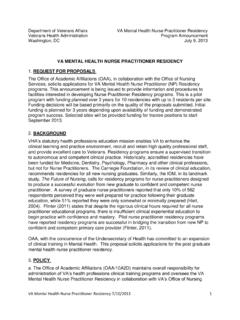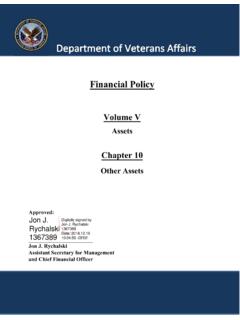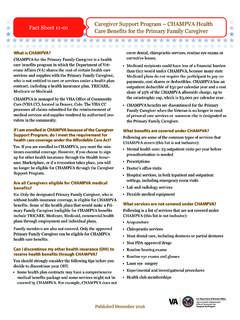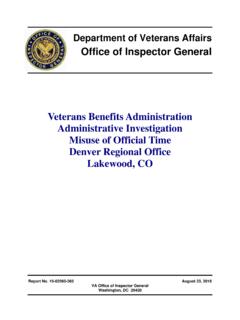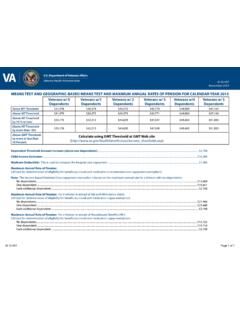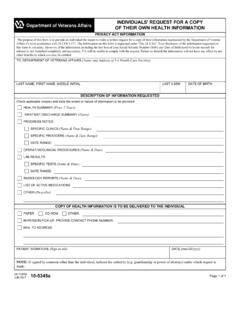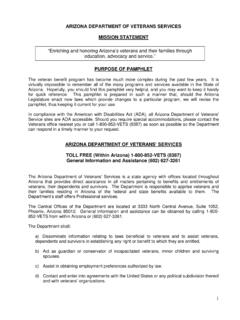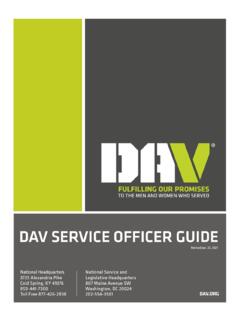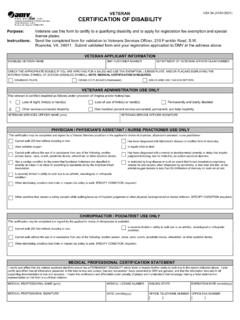Transcription of Department of ·Veterans Affairs ~:. ,,.
1 ~: Department of ~ veterans Affairs ~:.. ~ . ' -~ ,,.. 2 VA History in Brief Table of Contents Chapter Page 1 Colonial era through the Civil War 3 2 World War I era 7 3 World War I bonus march 9 4 veterans Administration established, World War II, GI Bill 12 5 Post World War II through the Korean War 15 6 Vietnam War era, Agent Orange 18 7 Post-Vietnam era 22 8 VA becomes a Cabinet-level Department ; Persian Gulf War 26 9 Women veterans ; health care reform 28 10 A look at today s VA 32 VA History in Brief 3 Chapter 1 american Colonies From the beginning, the English colonies in North America provided pensions for disabled veterans .
2 The first law in the colonies on pensions, enacted in 1636 by Plymouth, provided money to those disabled in the colony s defense against Indians. Other colonies followed Plymouth s example. Battle of Lexington, April 19, 1779 In 1776 the Continental Congress sought to encourage enlistments and curtail desertions with the nation s first pension law. It granted half pay for life in cases of loss of limb or other serious disability. But because the Continental Congress did not have the authority or the money to make pension payments, the actual payments were left to the individual states. This obligation was carried out in varying degrees by different states. At most, only 3,000 Revolutionary War veterans ever drew any pension. Later, grants of public land were made to those who served to the end of the war.
3 In 1789, with the ratification of the Constitution, the first Congress assumed the burden of paying veterans benefits. The first federal pension legislation was passed in 1789. It continued the pension law passed by the Continental Congress. By 1808 all veterans programs were administered by the Bureau of Pensions under the Secretary of War. Subsequent laws included veterans and dependents of the War of 1812, and extended benefits to dependents and survivors. There were 2,200 pensioners by 1816. In that year the growing cost of living and a surplus in the Treasury led Congress to raise allowances for all disabled veterans and to grant half-pay pensions for five years to widows and orphans of soldiers of the War of 1812. This term later was lengthened. A new principle for veterans benefits, providing pensions on the basis of need, was introduced in the 1818 Service Pension Law.
4 The law provided that every person who had served in the War for Independence and was in need of assistance would receive a fixed pension for life. The rate was $20 a month for officers and $8 a month for enlisted men. Prior to this legislation, pensions were granted only to disabled veterans . 4 VA History in Brief The result of the new law was an immediate increase in pensioners. From 1816 to 1820, the number of pensioners increased from 2,200 to 17,730, and the cost of pensions rose from $120,000 to $ million. When Congress authorized the establishment of the Bureau of Pensions in 1833, it was the first administrative unit dedicated solely to the assistance of veterans .
5 The new Bureau of Pensions was administered from 1833 to 1840 as part of the Department of War, and from 1840 to 1849 as the Office of Pensions under the Navy Secretary. The office then was assigned to the new Department of the Interior, and renamed the Bureau of Pensions. In 1858 Congress authorized half-pay pensions to veterans widows and to their orphan children until they reached the age of 16. Civil War Legacy When the Civil War broke out in 1861, the nation had about 80,000 war veterans . By the end of the war in 1865, another million veterans had been added to the rolls. This included only veterans of Union forces. Confederate soldiers received no federal veterans benefits until 1958, when Congress pardoned Confederate servicemembers and extended benefits to the single remaining survivor.
6 President Lincoln at the Antietam battlefield, October 1862 The General Pension Act of 1862 provided disability payments based on rank and degree of disability, and liberalized benefits for widows, children and dependent relatives. The law covered military service in time of peace as well as during the Civil War. The act included, for the first time, compensation for diseases such as tuberculosis incurred while in service. Union veterans also were assigned a special priority in the Homestead Act of 1862, which provided Western land at $ an acre. The year 1862 also marked the establishment of the National Cemetery System, to provide burial for the many Union dead of the Civil War. The first national effort to provide medical care for disabled veterans in the United States was the Naval Home, established in Philadelphia in 1812.
7 This was followed by two facilities in Washington, -- the Soldiers Home in 1853 and St. Elizabeth s Hospital in 1855. 5 VA History in Brief In his second inaugural address in 1865, President Lincoln called upon Congress to care for him who shall have borne the battle and for his widow, and his orphan. This was later adopted as the VA s motto. Immediately after the Civil War, the number of disabled veterans in need was so great that Congress in 1865 authorized the National Asylum for disabled Volunteer Soldiers. The name was changed to the National Home for disabled Volunteer Soldiers in 1873. The federal organization had individual residences, called branches. The first branch opened in Togus, Maine. Primarily providing room and board, these homes also gave incidental medical care to disabled and indigent veterans , regardless of whether their disabilities were service related.
8 In the years that followed, national homes cared for veterans of the Mexican, Civil, Indian and Spanish- american Wars, and for noncombat veterans as well. By the late 1920s, medical care at the homes had risen to hospital level. After the Civil War, veterans organized to seek increased benefits. The Grand Army of the Republic, consisting of Union veterans of the Civil War, was the largest veterans organization emerging from the war. As part of the effort between 1865 and 1870 to rebury battlefield casualties, 70 national cemeteries were opened and 300,000 remains gathered and reburied. Of the total buried, 142,000 were unknown. In 1873 Congress authorized national cemetery burial for all honorably discharged Union veterans . The Consolidation Act in 1873 revised pension legislation, paying on the degree of disability rather than the service rank.
9 The Act also began the aid and attendance program, in which a disabled veteran is paid to hire a nurse or housekeeper. The increase in the number of veterans following the Civil War led Congress in 1881 to authorize the construction of a new building for the Bureau of Pensions. In 1887 the Pension Building on G Street in Northwest Washington, , was completed. The Bureau of Pensions remained there until 1926, when it was moved to 19th and F Streets. Until 1890, Civil War pensions were granted only to servicemen discharged because of illness or disability attributable to military service. The Dependent Pension Act of 1890 substantially broadened the scope of eligibility, providing pensions to veterans incapable of manual labor. Within the next three years the number of veterans on the pension roll increased from 489,000 to 996,000 and expenditures doubled.
10 Legislation passed in the 19th century had established a general pension system that could be applied to future pension recipients. As a consequence, new pension laws did not follow the Spanish- american War in 1898 or the Philippine Insurrection, 1899 to 1901. The first important pension law in the 20th century was the Sherwood Act of 1912, which awarded pensions to all veterans . A similar law in the 19th century had limited recipients to Revolutionary War veterans . Under the Sherwood Act, veterans of the 6 VA History in Brief Mexican War and Union veterans of the Civil War could receive pensions automatically at age 62, regardless of whether they were sick or disabled .
